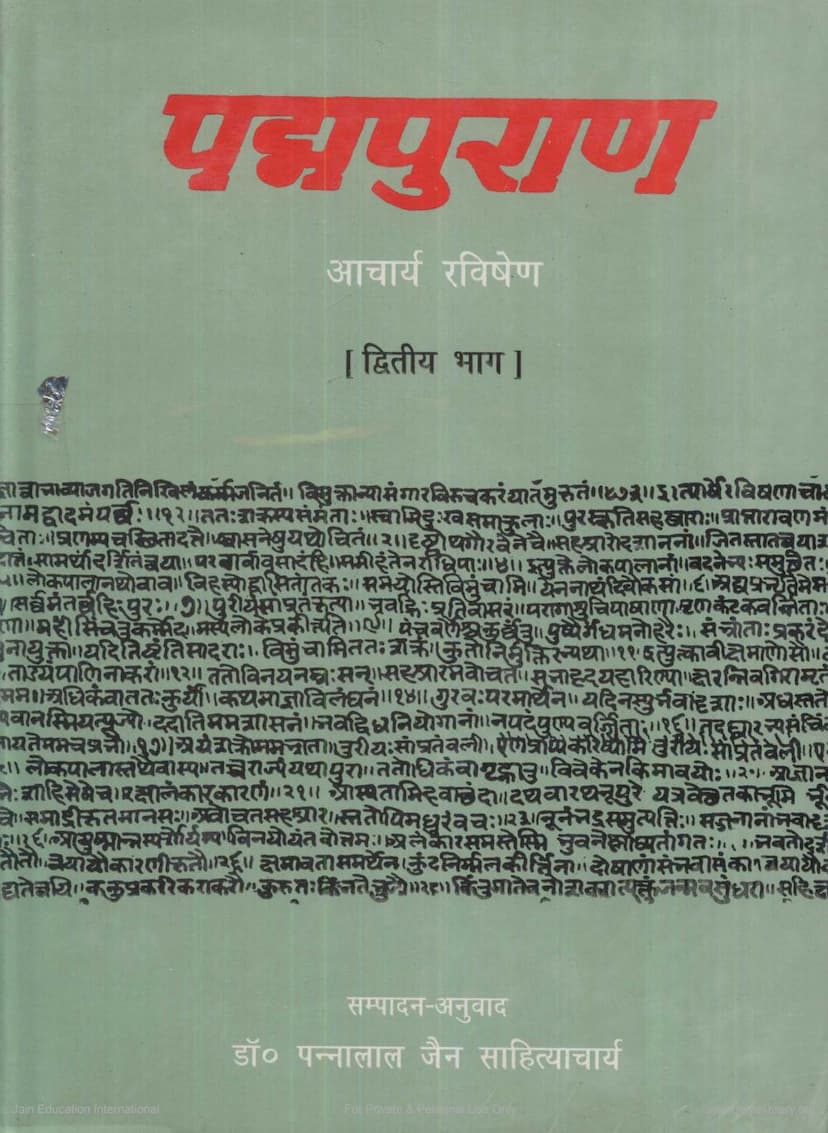Padmapuran Part 2
Added to library: September 2, 2025

Summary
This is a summary of the Jain text "Padmapuran Part 2" by Acharya Ravishana, as found in the provided text and catalog link. This summary focuses on the events and themes described in the text, particularly concerning the life and journey of Rama, as depicted in this Jain tradition.
Padmapuran Part 2: A Summary
Padmapuran, also known as Padmacharitam, is a significant Jain epic poem authored by Acharya Ravishana in the 7th century CE. Considered a masterpiece among Sanskrit biographical Mahakavyas, it is lauded for its poetic artistry, psychological depth, and vivid character portrayals. The second part of this epic continues the narrative of Rama, who is recognized as a Padmanabha or Padma in Jain tradition and is counted among the sixty-three illustrious persons (Shalaka Purushas).
Key Events and Themes:
The provided text details several pivotal moments and character arcs within the Padmapuran narrative. The summary highlights the following:
- The Birth of Sita and Bhamandal: The text begins by describing the past lives of Sita and Bhamandal, the children born to King Janaka's queen Videha. It recounts past animosities and their consequences, setting the stage for their future roles.
- The Abduction of Sita and Bhamandal: It details the birth of both a son and daughter from Queen Videha's womb. The demonic asura Mahakal, driven by past enmity, attempts to abduct the son immediately after birth, but later out of compassion, he drops him from the sky, adorned with divine earrings. The Vidhyadhara Chandragati rescues the child and entrusts him to his childless queen Pushpavati, who names the boy Bhamandal. The text also describes Queen Videha's lament and King Janaka's solace.
- The Mlechha Invasion and Janaka's Plea to Dasharatha: The narrative shifts to an invasion of King Janaka's kingdom by Mlechha kings. King Janaka seeks aid from King Dasharatha, who promptly arrives and defeats the Mlechhas. Impressed by Dasharatha's prowess, Janaka decides to betroth his daughter Sita to Dasharatha's son Rama.
- Narada's Intervention and the Creation of the Painted Image: The sage Narada visits Sita's palace and, upon seeing his reflection in a mirror, becomes fearful. Narada, seeking revenge on Sita, creates her portrait and leaves it in a garden. Bhamandal becomes enchanted by the portrait, which further fuels his desires.
- The Elopement of King Janaka and the Proposed Condition: With the consent of King Chandragati, a Vidhyadhara named Chapalvega abducts King Janaka in the guise of a horse and takes him to Ratnupur. Impressed by the city's splendor, Janaka is offered Bhamandal's hand in marriage for Sita. However, Janaka firmly states that Sita is already promised to Rama. The text culminates with the condition that Sita can only be won if Rama can string the Vajravarta bow; otherwise, Bhamandal will win her.
- Rama's Victory and the Marriage Ceremony: King Janaka returns to Mithila. The Swayamvara ceremony takes place, where Rama successfully strings the Vajravarta bow and wins Sita. Lakshmana also wins eighteen princesses by stringing another bow. Bharat marries Lokasundari, daughter of King Janaka's brother Kanaka.
- Dasharatha's Past Lives and the Path to Liberation: The narrative then delves into descriptions of Dasharatha's past lives by sage Sarvabhutahita, which further intensifies Dasharatha's detachment. He decides to renounce the world and announces Rama's coronation. However, Kaikeyi, fulfilling her boon, demands the throne for Bharat. Dasharatha's dilemma and Rama's steadfast resolve are highlighted.
- Rama's Exile and Bharata's Rule: The text describes Rama's voluntary departure to the forest with Sita and Lakshmana, despite the populace's affection.
- The Journey to Dhandak Forest and Encounters: The summary outlines the significant events of Rama and Lakshmana's journey, including their encounter with King Vajrakarna and Singhodar, whom they ultimately reconcile. They also meet Kalyanamala, a princess disguised as a prince, and help her father.
- The Confrontation with Ravana's Forces: The text details the escalating conflict with Ravana's forces, including the death of his relatives Khara and Dushana, the abduction of Sita by Ravana, and the subsequent efforts by Rama and Lakshmana to rescue her, aided by Hanuman and Sugriva.
- The War in Lanka and the Resolution: The summary touches upon the epic war in Lanka, the defeat of Ravana, and the eventual reunion of Rama and Sita.
- The Jain Interpretation of Rama: Importantly, the text emphasizes that within the Jain tradition, Rama is revered as a virtuous ruler and is recognized as one of the Tirthankaras or Shalaka Purushas, embodying principles of righteousness and detachment. His life story is presented as an illustration of Jain philosophy and ethics.
The provided text covers the initial stages of the Ramayana story from a Jain perspective, emphasizing the importance of dharma, virtue, and detachment from worldly desires, which are central tenets of Jainism. The narrative highlights the cyclical nature of karma and rebirth, as well as the path to liberation.